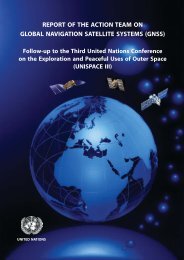Proceedings of the Workshop - United Nations Office for Outer ...
Proceedings of the Workshop - United Nations Office for Outer ...
Proceedings of the Workshop - United Nations Office for Outer ...
- No tags were found...
Create successful ePaper yourself
Turn your PDF publications into a flip-book with our unique Google optimized e-Paper software.
EXPANDING GLOBAL NAVIGATION SERVICESunavailability o f GNSS signals, could be subsumedunder a provision such as Article 2 <strong>of</strong> <strong>the</strong> LiabilityConvention.175A less cumbersome regime should be devised thatempowers aggrieved objects <strong>of</strong> international law to beable to successfully intiate actions against states.Apart from cases o f jamming and intentionalinterference, <strong>the</strong>re are situations where a degradation ordisruption <strong>of</strong> <strong>the</strong> navigation signals or data error couldresult in some <strong>for</strong>m o f damage to aircraft, passengersand to persons and property on <strong>the</strong> surface <strong>of</strong> <strong>the</strong> earth.These are cases which could fa ll under <strong>the</strong> regime <strong>of</strong>space law. Activities involving <strong>the</strong> exploration and use<strong>of</strong> outer space, regulated in <strong>the</strong> <strong>Outer</strong> Space Treaty arealso governed by a detailed regime under <strong>the</strong> LiabilityConvention. The Liability Convention establishes anabsolute liability regime <strong>for</strong> <strong>the</strong> launching state when aspace object causes damage to persons and property on<strong>the</strong> surface <strong>of</strong> <strong>the</strong> earth or to aircraft in flight. The mostrelevant provision <strong>of</strong> that Convention is Article II whichstates:“A launching State shall be absolutely liable topay compensation <strong>for</strong> damage caused by itsspace object on <strong>the</strong> surface o f <strong>the</strong> earth or toaircraft in flight.”Difficulties with this assertion is to establish <strong>the</strong>following:1. That a GNSS satellite can cause damage asperceived under Article II2. That <strong>the</strong> damage in question is caused byGNSS Satellites3. That <strong>the</strong> claimant can indeed claim under <strong>the</strong>Liability ConventionO f <strong>the</strong>se, I will focus on <strong>the</strong> first two and simplysay in relation to <strong>the</strong> last that locus standi is notgranted to natural persons under Liability Conventionand <strong>the</strong> claims procedure is burdensome.If GNSS and o<strong>the</strong>r satellite applications willcontinue to be accepted, it will be on <strong>the</strong> condition thatlegal certainty exists not only in relation to causationbut also in relation to claimant aspects. Each claimantshould be able to seek satisfaction under such a regime.Regarding <strong>the</strong> first two issues, causal connectionbetween <strong>the</strong> damage and <strong>the</strong> space object is <strong>the</strong> mainelement to be established by a claimant. The launchingstate is absolutely liable to pay compensation only whendamage is "caused by its space object102. RegardingGNSS signal liability, it will not be enough to establisha causal connection between any space object and <strong>the</strong>damage. The object must without doubt be a GNSSsatellite belonging to that state against which <strong>the</strong> claimhas been brought. In <strong>the</strong> provision <strong>of</strong> GNSS signals,two institutions have been identified, <strong>the</strong> primaryprovider and <strong>the</strong> secondary provider. The claimant mustbe categorical about which <strong>of</strong> <strong>the</strong> primary or secondarysystems caused <strong>the</strong> damage. In establishing <strong>the</strong> linkagewith a primary signal satellite, it may be advantageousif <strong>the</strong> secondary signal providers also suffered similardamage simultaneously, or observed <strong>the</strong> cause <strong>of</strong> <strong>the</strong>damage.The main issue in establishing causation is onwhich test to be used. While some writers like prefer touse <strong>the</strong> test o f “direct hit” in my view <strong>the</strong> Conventiondoes not support such an approach. Nei<strong>the</strong>r does <strong>the</strong>travaux preparatoires nor a commonsenseinterpretation o f <strong>the</strong> treaty. The correct test to beadopted in establishing <strong>the</strong> causal connection should be<strong>the</strong> proximity test.The difference between <strong>the</strong> direct hit test and <strong>the</strong>proximity test is that <strong>the</strong> first will want to establish aphysical connection between <strong>the</strong> aircraft in flight or <strong>the</strong>ship on <strong>the</strong> sea and <strong>the</strong> GNSS satellite while <strong>the</strong> o<strong>the</strong>rwould want to establish whe<strong>the</strong>r a collision or crashcould be a normal consequence <strong>of</strong> <strong>the</strong> type o f failure toreceive GNSS signals under critical conditions <strong>of</strong>instrument flight rules? This is a technical questionwhich may finally need technical and systemengineering expertise to settle authoritatively. It may102 B.A. Hurwitz, Space Liability <strong>for</strong> <strong>Outer</strong> Space Activities inAccordance with <strong>the</strong> 1972 Convention on International Liability<strong>for</strong> Damages Caused by Space Objects (1992), 31.
















